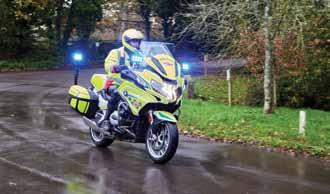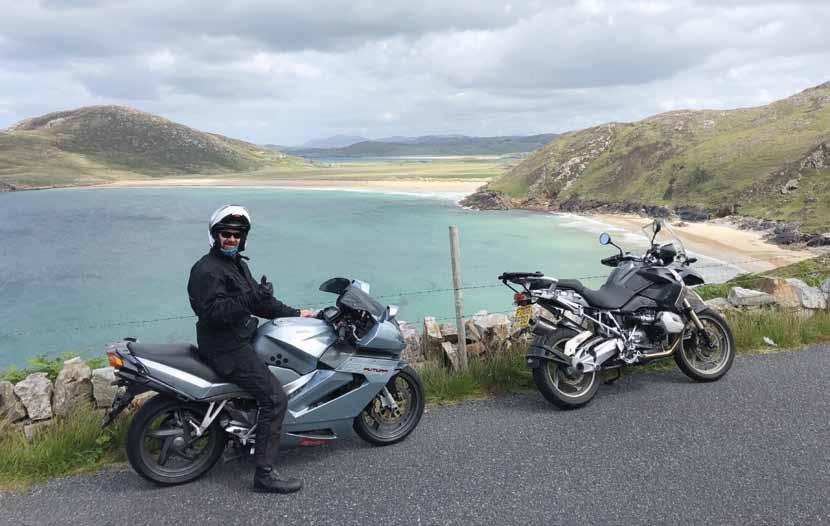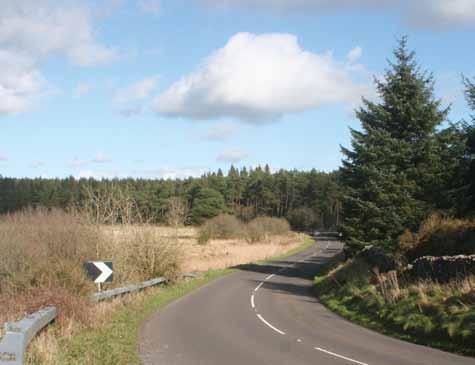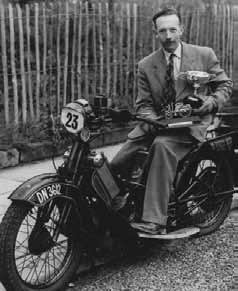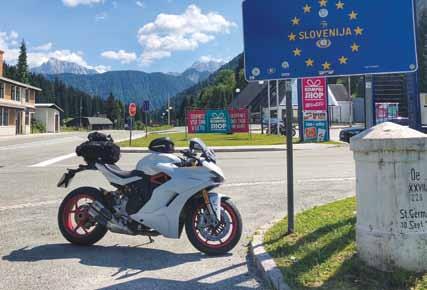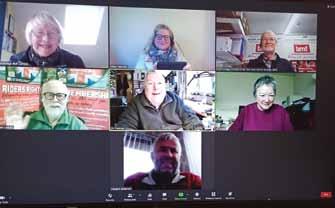
6 minute read
Bikes for Good
DOC BIKE
First of a new series on motorcycles doing useful – or in this case life saving – jobs. LaRa BatteRSBY outlines the docBike scheme
Advertisement
Any air ambulance clinician who has worked through a summer season will tell you that motorcyclists do not fare well in a high-speed collision. Without a roll cage, seat belts, crumple zones or air bags, the forces that are involved when a rider crashes at speed are so great, that regardless of the skill and seniority of the medical crew, or how much blood is carried, many motorcyclists die at the scene of the incident. If we really want to save the lives of motorcyclists, preventing them from crashing in the first place is a far more effective strategy.
This was identified by Dr Ian Mew, a Consultant in Anaesthetics and Critical Care Medicine, a Critical Care Doctor aboard the Dorset and Somerset Air Ambulance and former Director of Major Trauma at Dorset County Hospital. In 2013, in collaboration with PC Chris Smith from Dorset Police, a motorcycle
Below: DocBike works with other organisations on the Biker Down scheme to improve skills and reduce crashes
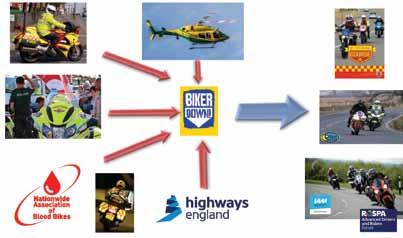
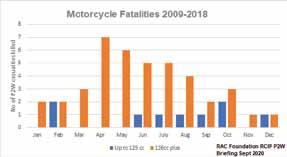
Above: Fatalities peak in April
injury prevention strategy was piloted. This has now become so successful, that the DocBike charity has been formed and the scheme is being rolled out across the country.
What is DocBike?
DocBike puts doctors on motorcycles, combining a highly qualified doctor or paramedic with a bike, as an effective fast responder to incidents. All of our riders are serving doctors, paramedics or practitioners who look after critically ill and injured patients in the pre-hospital environment as part of their day job. They give their time voluntarily to help keep motorcyclists on two wheels because they know the devastation that can be caused when a motorcyclist is involved in a crash. Wherever possible, this doctor or paramedic also works on the local air ambulance, as it is part of their everyday job to treat and save the most severely injured and sick patients, and to help them to reach hospital alive.
Think About It We also work at a
Every year, around 16,000 motorcyclists are injured in the UK national level to prevent motorcycle collisions and to help bikers develop their skill and reduce their (DfT, 2019), and in an risk of crashing in the first average week six are place. killed and 112 seriously In 2016, the DocBike injured (DfT 2019). project was awarded the Trauma Audit and Research Network prize for the best use of its data. This was the first time that TARN data had been used for injury prevention purposes, but when cross-referenced with police collision investigations, it allowed them to identify which motorcyclists were most likely to be killed or critically injured on Dorset roads in the future.
This was vital information on who to engage with and encourage to take rider skills courses. Their research showed that 81% of motorcyclists who were killed or critically injured would not have been involved in a collision at all, had they been aware of why motorcyclists crash, been able to identify the hazards that DocBike and some other enhanced riding organisations teach and altered their riding technique according to the situation.
Engagement
If you ask a fellow biker if they want to come on a bike safety course, they will invariably say ‘no’ explaining that they have been riding for 20 years and know how to ride a bike. However, if you offer them something that they do want, such as a free BikerDown course, which covers how to keep your mate alive if they come off their bike, the response and uptake is positive.
BikerDown is a free course, created by Jim Sanderson from Kent Fire and Rescue Service and is taught all over the UK. With an air ambulance clinician teaching the module on how to keep someone alive, we have found that riders really do want to learn these vital skills. This includes motorcyclists in our ‘at-risk’ profile, so we have a captive audience with those bikers who are most likely to be killed or critically injured in the future.
the course runs over one evening and comprises three modules: • How to manage the scene of an incident, call for help and keep yourself and others safe • What you can realistically do to help keep someone alive until the ambulance arrives • How you can make yourself more visible and avoid being knocked off your own bike in the future • It is in this last session, where riders start to appreciate that there are things that they can do to reduce the risk of them being involved in a serious collision, that encourages them to do a further course, which will improve their awareness and make them a more skilful rider.
As a policy, DocBike avoids using the word ‘safety’, as this causes people to disengage. Everyone wants to be considered a better or more skilful rider, so using positive language like this seems to lead to a much better uptake. Nationally, DocBike has worked with agencies to use BikerDown as the primary step in engaging ‘at-risk’ motorcyclists. Our work with the National Fire Chief’s Council, which owns the course, ensures that everyone attending a BikerDown course is encouraged to take up further rider training when they leave.
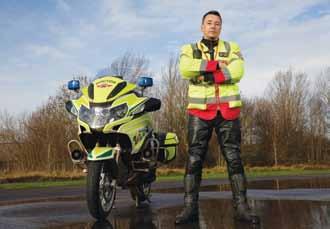
Road Signs
DocBike started as a Dorset organisation, but as its goal is to eradicate motorcycle deaths and serious injuries across the UK, it now works with national organisations on how do this. Take road signs. Every year, motorcycle fatalities peak in the springtime. This may be because riders are a bit rusty after not riding much over the winter period, because other road users are not used to seeing bikes out on the roads, or most likely a combination of both. The annual spike could be worse this year, after the multiple lockdowns of the past 12 months.
The human brain is not very good at ‘seeing’ small objects travelling towards it at speed. A high proportion of motorcycle collisions on Dorset’s roads occur when another vehicle pulls into the path of a motorcycle, which is unable to stop in time.
This year, DocBike has worked with psychologists and used evidence-based research to design new road signs to warn other road users about bikes.
After seeking feedback from the public on two options, the signs were put up on Dorset roads in March and will be in place until October. The outcome from this research will be shared nationally, so if the signs are effective in reducing collisions you may well see them rolled out nationally.
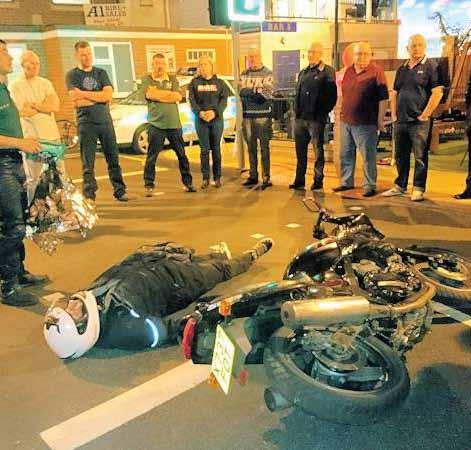

Above: Bournemouth BikerDown course at Safewise Left: Soon to be seen on a road near you? Below: Doctors on bikes can respond quickly to provide vital care on the scene
How to Help
Everyone involved with the charity is a volunteer, but it’s still an expensive business. It costs approximately £50,000 to put a DocBike on the road, which sounds a lot, but compared to the estimated £2.1 million for each human life lost (Department for Transport), this is nothing.
Regular contributions make a huge difference. By chipping in just £2 per month, you can help provide us with a regular, sustainable income which enables us to direct resources to stop riders from having a collision and to kit out the response motorcycles with medical equipment. That way, if the worst happens to a motorcyclist on the road, we will be there for them.
Find Out More
For more information about DocBike and how you can get involved, including making a regular contribution, visit:
www.DocBike.org
